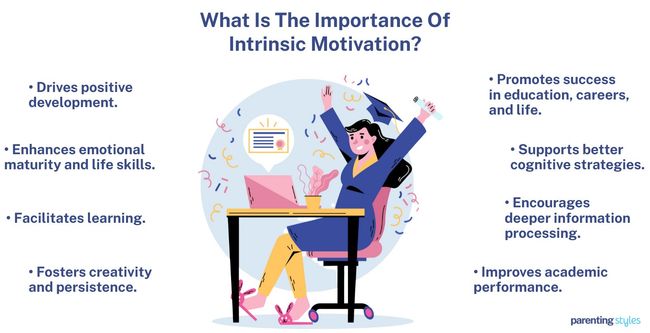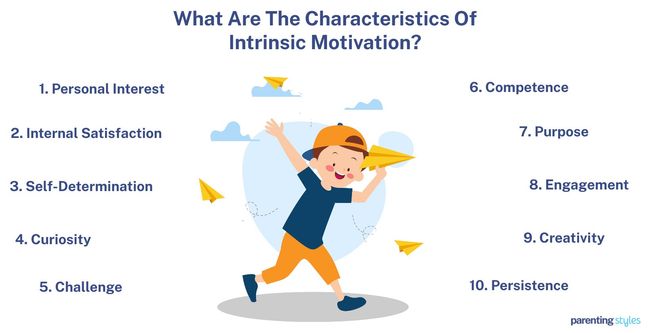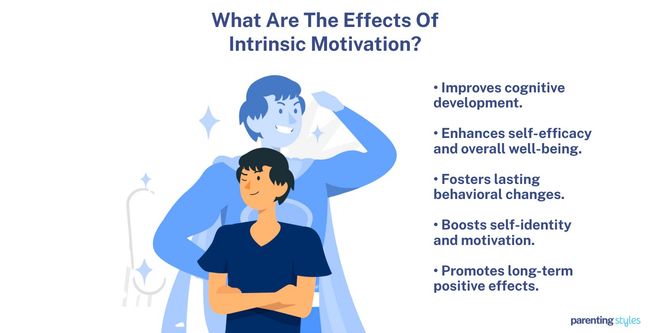Intrinsic Motivation: Definition, Characteristics And Examples
Intrinsic motivation is an internal drive that propels individuals to perform activities for enjoyment rather than external rewards. Intrinsic motivation emerges from a person’s genuine interest, curiosity, and desire. The three main elements of intrinsic motivation are autonomy, mastery, and relatedness. Intrinsic motivation is particularly significant in child development. Intrinsic motivation catalyzes cognitive and emotional growth. Intrinsically motivated children experience enhanced learning capabilities, deeper information processing, strategic thinking, and persistence to challenges. Intrinsic motivation enables children to develop critical life skills, emotional maturity, and a robust sense of self-identity through genuine interest and passion. Extrinsic motivation depends on rewards or recognition. Research suggests that external rewards diminish intrinsic motivation. Intrinsic motivation builds long-term skills and resilience. Using structured yet flexible learning experiences, meaningful choices, and relationship-building promotes intrinsic motivation and helps children develop an enduring passion for learning.

What Is Intrinsic Motivation?
Intrinsic motivation is a psychological concept that refers to a person’s inner drive to do an activity because the process is enjoyable, interesting, or inherently satisfying. Intrinsically motivated individuals engage in an activity or behavior due to internal desires and interests, not external factors, such as rewards, praise, recognition, or compensation, according to a 2000 study titled “Intrinsic and Extrinsic Motivations: Classic Definitions and New Directions,” conducted by Richard M. Ryan et al. and published in the Contemporary Educational Psychology Journal.
The foundation of intrinsic motivation lies in satisfying basic psychological needs, namely autonomy, competence, and relatedness. Autonomy is the need to feel in control of one’s actions and decisions. Competence involves the desire to master tasks and challenges. Relatedness is the need to connect with others. A person is more likely to engage in activities with intrinsic motivation when these needs are met, according to the self-determination theory (SDT) proposed by psychologists Edward Deci and Richard Ryan. The SDT emphasizes the role of intrinsic motivation in fostering psychological well-being and optimal functioning.
What Is The Importance Of Intrinsic Motivation?
The importance of intrinsic motivation lies in the ability to drive positive development. Intrinsic motivation facilitates learning. Engaging in intrinsically motivated activities fosters strategic thinking, creativity, and persistence, enabling individuals to achieve education, careers, and personal pursuits.
Intrinsic motivation is associated with emotional maturity, identity, social skills, and other life skills, according to a 2011 study titled “Intrinsic Motivation and Positive Development,” conducted by Reed W. Larson et al. and published in Advances in Child Development and Behavior journal.
Children perform and learn better because of greater cognitive strategies such as critical thinking, elaboration, and expansive reasoning. Inherent interest in activities allows children to process information deeper than others, contributing to better academic performance.

How Does Intrinsic Motivation Affect Child Growth?
Intrinsic motivation affects child growth by promoting cognitive and emotional development. Young children who are intrinsically motivated have more willingness to learn, according to a 2014 study titled “Early years education are young students intrinsically or extrinsically motivated towards school activities A discussion about the effects of rewards on young children’s learning,” conducted by Evgenia Theodotou and published in the Research in Teacher Education journal. Children engage actively in activities and look forward to learning new things. Intrinsic motivation fosters emotional development and child growth by generating positive emotions, according to a 2011 study titled “Intrinsic Motivation and Positive Development,” conducted by Reed W. Larson et al. and published in Advances in Child Development and Behavior journal.
Genuine motivation for an activity fosters positive feelings, helping children turn interest into passion. For example, a childhood interest in living creatures and animals led Jane Goodall, a pioneering scientist and conservationist, to become a world-renowned primatologist. Her intrinsic passion for animals revolutionized our understanding of chimpanzees through decades of groundbreaking field research in Tanzania.
How Does Intrinsic Motivation Differ From Extrinsic Motivation?
Intrinsic motivation differs from extrinsic motivation by arising from an individual’s enjoyment and inherent satisfaction in performing an activity, whereas extrinsic motivation comes from the desire for a separable outcome other than enjoyment, such as rewards, praise, or social recognition. Intrinsic vs extrinsic motivation plays a crucial role in understanding the driving forces behind behavior. Extrinsic motivation is often driven by the desire to get rewards or avoid punishment, according to a 2000 study titled “Intrinsic and Extrinsic Motivations: Classic Definitions and New Directions,” conducted by Richard M. Ryan et al. and published in the Contemporary Educational Psychology journal. Examples of rewards include praise, money, or medals.
Intrinsic motivation improves learning, whereas extrinsic motivation reduces children’s motivation in school. Rewards and prizes undermine the joy and excitement of learning, leading to poorer school outcomes, as detailed in the 2015 study titled “Is Intrinsic Motivation Better Than Extrinsic Motivation?” conducted by Elaine Clanton Harpine and published in Group-centered Prevention in Mental Health.
Intrinsic motivation fuels persistence in the face of difficulty by instilling strong-will determination, whereas extrinsic rewards do not build the skills needed to achieve long-term goals and often encourage perfectionistic behaviors.
What Are The Characteristics Of Intrinsic Motivation?
The characteristics of intrinsic motivation include attributes that influence and enhance a person’s inherent drive to engage in activities. Here are 10 characteristics of intrinsic motivation.
1. Personal Interest
Personal interest refers to an individual’s curiosity or liking for a specific activity or subject. Interest in activities generates positive emotions and piques curiosity. Deeper interest in the activity gradually develops into passion, supporting intrinsic motivation. For example, someone who enjoys writing novels finds their primary motivation in the creative process and the satisfaction of self-expression rather than in external rewards or recognition.
2. Internal Satisfaction
Internal satisfaction refers to a sense of fulfillment or contentment that arises within an individual. Intrinsic motivation develops from internal satisfaction as the basic psychological needs of autonomy, competence, and relatedness are fulfilled. Meeting the needs makes activities enjoyable and meaningful. Internally satisfied individuals are motivated to continue engaging. An example of internal satisfaction is volunteering in community work to satisfy the innate need for connection and mutual support.
3. Self-Determination
Self-determination is the ability to set goals, make decisions, and take responsibility for one’s life. Intrinsic motivation arises when individuals engage in activities driven by their own choices. For example, children are intrinsically motivated when they draw on their own rather than being instructed to do so in exchange for rewards.
4. Curiosity
Curiosity is the desire to learn or know more about something, often driven by a sense of wonder or interest in discovering new information or understanding a mystery. Curiosity drives intrinsic motivation. Curious individuals want to explore, learn, or engage in new experiences. For example, a child is curious about floatation experiments with different objects to see which floats or sinks in water. The child’s actions are motivated by a natural desire to understand the concept of buoyancy, not by external rewards such as praise or prizes.
5. Challenge
A challenge is a demanding or stimulating situation, career, or object. A challenge is a task or goal stimulating natural curiosity and drive to explore, learn, and achieve. Challenges engage individuals by presenting opportunities to master something new or complex. Such opportunities align with the desire for growth and meaningful accomplishments. Babies are naturally curious about new things. Children eventually become attracted to goals that involve increasing complexity, according to a 2011 study titled “Intrinsic Motivation and Positive Development,” conducted by Reed W. Larson et al. and published in Advances in Child Development and Behavior. For example, a student who enjoys the challenge of advanced mathematics is intrinsically motivated. Their desire to overcome a challenge and master a subject becomes an internal motivation that drives persistence and personal growth.
6. Competence
Competence is the ability to do something successfully or sufficiently. Individuals who feel capable and confident in their abilities are more likely to be intrinsically motivated. A sense of competence leads to a positive feedback loop, where successful experiences further boost motivation and increase effort and engagement. A student learning to play the piano practices diligently and experiences satisfaction after mastering a challenging piece. The sense of competence gained from improving piano skills drives the student to practice more, enjoying the process without requiring external pressure or incentives.
7. Purpose
Purpose refers to the reason for doing or creating something. Purpose amplifies intrinsic motivation by connecting actions to a meaningful outcome or long-term vision. For example, a teacher dedicates time to creating engaging lessons, not for monetary gain, but out of a genuine desire to help students develop critical thinking skills. The teacher’s sense of purpose stems from a belief in education’s transformative power, which fuels intrinsic motivation to excel.
8. Engagement
Engagement refers to active involvement, focus, and participation in an activity. Engagement is observed in intrinsically motivated individuals through sustained attention and focus. Intrinsic motivation pushes individuals to demonstrate consistent effort in activities without needing external prompts. For instance, a college student decides to take extra classes in French after learning the language in high school. Sustained focus in the language helped the student commit to something without needing external drives such as recognition or validation.
9. Creativity
Creativity involves generating new, unique, or different ideas and alternatives. Individuals with higher intrinsic motivation are more likely to have creative outcomes. A musician writing a song purely for the joy of creating music, without concern for fame or financial reward, demonstrates intrinsic motivation. Composing feels rewarding on its own, which often leads to more innovative and authentic music compared to composing only for commercial success.
10. Persistence
Persistence is the ability to continue striving toward a goal despite challenges, setbacks, or difficulties. An intrinsically motivated person engages in activities for their inherent satisfaction and often persists. The enjoyment and fulfillment derived from the activity itself encourage sustained effort, even in the face of challenges.
Tasks that align with personal interests or a sense of purpose naturally promote long-term engagement. For example, a person deeply curious about solving puzzles persists through difficult problems because solving them is rewarding. The desire for mastery, learning, and self-improvement—core elements of intrinsic motivation—reinforces persistence, creating a cycle where progress fuels further effort.

What Are The Best Intrinsic Motivation Examples?
Some of the best examples of intrinsic motivation are in fields such as education, arts, sports, music, and language. Below are the best examples of intrinsic motivation across different areas of life.
- Education: A student exploring a subject like science or history out of personal interest and enjoyment, not because of a grade requirement.
- Arts: An artist painting or writing for the sheer pleasure of expressing thoughts and emotions without concern for external validation.
- Sports: An athlete perfecting a skill for the personal joy of progress and mastery rather than a competitive result.
- Music: A child learning to play an instrument out of enjoyment from making music rather than for validation from the audience.
- Language: Learning a new language because of the passion to pursue knowledge.
- Home: A child cleaning up toys to create imaginative scenarios, such as being a storekeeper organizing shelves or a superhero restoring order to the city.
- Work: An engineer designing new gadgets or prototypes purely out of interest in the challenge and problem-solving, not for profit.
- Relationships: Spending time with friends or family to nurture relationships and share meaningful experiences rather than seeking social status or personal gain.
- Leadership: Sharing knowledge and experience to help others grow without expecting compensation.
- Community: Volunteering for a cause out of a desire to help others and positively impact the community rather than for social media recognition.
How To Help Your Child Develop Intrinsic Motivation?
To help your child develop intrinsic motivation, redirect misbehavior to preserve autonomy, “catch them being good” to highlight their mastery in good behavior, and give them positive attention to strengthen the parent-child relationship. Ways to motivate a child intrinsically are listed below.
- Redirect Misbehavior: Redirect misbehavior by guiding a child’s focus from an undesirable action to a positive alternative, fostering appropriate behavior.
- Catch Them Being Good: Acknowledge and praise positive actions in real time to reinforce desirable behaviors and build self-esteem.
- Give Positive Attention: Positive attention reinforces good behavior through specific, genuine praise, encouraging its recurrence.
- Set Rules: Clear rules guide children on expectations, helping them internalize appropriate norms and routines.
- Explain Reasons: Reasoning helps children understand the impact of their actions and adopt socially appropriate behaviors.
What Are The Effects Of Intrinsic Motivation?
The effects of intrinsic motivation include cognitive development and positive psychological outcomes. Cognitive development involves improved learning, creativity, and problem-solving. Positive psychological outcomes encompass self-efficacy and overall well-being. Intrinsic motivation fosters lasting behavioral changes by encouraging self-identity and sustained motivation throughout life, as detailed in the 2019 study titled “Do Both Intrinsic and Identified Motivations Have Long-Term Effects?” conducted by Yuan Liu et al. and published in The Journal of Psychology.

What Are The Positive Effects Of Intrinsic Motivation In Children?
The positive effects of intrinsic motivation in children include improved learning, reasoning, cognitive processes, academic performance, and motivation. Below are 6 positive effects of intrinsic motivation in children.
- Improved Learning: Intrinsic motivation stimulates children’s attention and commitment to tasks. Heightened focus on activities makes mental work more efficient and effective, making learning a more engaging experience.
- Reasoning: Children become more likely to think outside the box. Intrinsic motivation encourages deeper and more complex levels of thinking, allowing children to have a more dynamic and creative approach to problem-solving and learning, according to a 2015 study titled “Is Intrinsic Motivation Better Than Extrinsic Motivation?” conducted by Elaine Clanton Harpine and published in Group-centered Prevention in Mental Health.
- Cognitive Processes: Cognitive processes refer to the mental activities of acquiring, processing, storing, and using information. Children who study because of genuine interest in a topic create more mental images and produce more thoughts about materials, enabling better cognitive processes.
- Academic Performance: Intrinsic motivation is linked to greater school effort due to deeper learning approaches and less tendency to avoid tasks. Mathematics achievement is strongly greater in students motivated by internal rewards, according to a 2019 study titled “Do Both Intrinsic and Identified Motivations Have Long-Term Effects?” conducted by Liu Yuan et al. and published in The Journal of Psychology.
- Sustained Motivation: Children who enjoy tasks for their own sake are more likely to be committed to completing the activities. The sense of enjoyment and accomplishment boosts children’s motivation, making tasks feel rewarding and reinforcing intrinsic motivation. For example, studying math and science without outside rewards or pressure increases the likelihood of choosing STEM courses later on.
- Psychological Development: Psychological development includes emotional maturity, identity, and social skills. Intrinsic motivation is associated with higher self-esteem and persistence, improving children’s psychological well-being.
Are Intrinsic Motivation And Internal Motivation The Same?
No, intrinsic and internal motivations are not the same, although many use them interchangeably. Both intrinsic and internal motivation arise from within the individual. Intrinsic motivation refers to engaging in activities for the inherent satisfaction or interest in the activity. However, internal motives drive a person from the inside, regardless of whether that drive comes from enjoyment. Internal motivation comes from various internal desires, whether it is enjoyment, guilt, fear, or anxiety. Intrinsic motives drive intrinsic motivation, but internal motives can drive intrinsic or extrinsic motivation, according to a 1992 study titled “Beyond the Intrinsic-Extrinsic Dichotomy: Self-Determination in Motivation and Learning” by Edward L. Deci et al., published in Motivation and Emotion.
An example of intrinsic motivation is a child who paints because the process is enjoyable. An example of internal motivation is a child who studies hard due to fear of being the last in class. The child studies hard due to internal motivation because the fear of underperforming comes from within, but it is not intrinsic motivation, as the child is not studying out of enjoyment or personal interest.
Intrinsic motivation is a type of internal motivation, but internal motivation is not necessarily intrinsic if the motivator is not an enjoyment of the activity.
What Are The Negative Effects Of Intrinsic Motivation In Children?
The negative effects of intrinsic motivation in children include difficulty transferring skills, difficulty handling expectations, risk of neglecting non-preferred tasks, reduced willingness to collaborate, and frustration from unrealistic goals. Below are 5 negative effects of intrinsic motivation.
- Difficulty Transferring Skills: Focusing too much on a single activity or interest results in difficulty applying or transferring skills to another activity. Intrinsic motivation focuses on context-specific goals or interests, which sometimes does not align seamlessly across different courses or subjects, making the transfer of skills difficult, according to a 2002 study titled Strategies for Motivating Students,” conducted by Matt DeLong et al. and published in Learning to Teach and Teaching Mathematics: Resources for Professional Development. For example, a student deeply motivated by an interest in creative writing excels in crafting engaging narratives but struggles to use the skills in a technical writing course, where the focus shifts to structure and clarity over creativity.
- Difficulty Handling External Expectations: Difficulty handling external expectations arises when children highly driven by intrinsic motivation perceive external pressures, rules, or structured environments as restrictive or misaligned with personal interests.
- Risk of Neglecting Non-Preferred Tasks: Children intrinsically motivated by certain activities avoid or dismiss tasks perceived as uninteresting, even if the tasks are essential for long-term growth or responsibility.
- Reduced Willingness to Collaborate: Strong intrinsic motivation sometimes causes reluctance to compromise or collaborate in group settings if personal interests conflict with shared goals or expectations.
- Frustration from Unrealistic Goals: Pursuing personal passions without considering realistic limitations leads to frustration or burnout when expectations are unmet, especially if support systems do not align with the child’s interests.